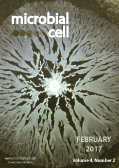Table of contents
Volume 4, Issue 2, pp. 35 - 68, February 2017
Cover: Swarming motility of
Pseudomonas aeruginosa transposon mutant A12c on minimal medium with glutamate as nitrogen and carbon source and 0.1% Gelzan after 24 hours incubation at 30°C (image by Anne E. Mattingly, Nachiket G. Kamatkar and Joshua D. Shrout, University of Notre Dame, USA); image modified by MIC. The cover is published under the Creative Commons Attribution (CC BY) license.
Enlarge issue cover
S. pombe placed on the prion map
Jacqueline Hayles
News and thoughts |
page 35-37 | 10.15698/mic2017.02.555 | Full text | PDF |
Abstract
Schizosaccharomyces pombe has been used extensively as a model organism, however it is only recently that the first prion in this organism, a copper transporter protein encoded by ctr4, has been conclusively demonstrated. Prions are found in a wide range of organisms and have been implicated in a number of human neurodegenerative diseases. Research into the biology of prions has been carried out mainly in the budding yeast Saccharomyces cerevisiae, however there are many questions still to be addressed. Now, with the identification of the Ctr4 prion in S. pombe, further work in the two yeasts and comparisons of prion biology in these organisms should lead to a greater understanding of prions and their role in disease.
Balanced CoQ6 biosynthesis is required for lifespan and mitophagy in yeast
Isabel González-Mariscal, Aléjandro Martín-Montalvo, Cristina Ojeda-González, Adolfo Rodríguez-Eguren, Purificación Gutiérrez-Ríos, Plácido Navas, and Carlos Santos-Ocaña
Research Articles |
page 38-51 | 10.15698/mic2017.02.556 | Full text | PDF |
Abstract
Coenzyme Q is an essential lipid with redox capacity that is present in all organisms. In yeast its biosynthesis depends on a multiprotein complex in which Coq7 protein has both catalytic and regulatory functions. Coq7 modulates CoQ6 levels through a phosphorylation cycle, where dephosphorylation of three amino acids (Ser/Thr) by the mitochondrial phosphatase Ptc7 increases the levels of CoQ6. Here we analyzed the role of Ptc7 and the phosphorylation state of Coq7 in yeast mitochondrial function. The conversion of the three Ser/Thr to alanine led to a permanently active form of Coq7 that caused a 2.5-fold increase of CoQ6 levels, albeit decreased mitochondrial respiratory chain activity and oxidative stress resistance capacity. This resulted in an increase in endogenous ROS production and shortened the chronological life span (CLS) compared to wild type. The null PTC7 mutant (ptc7∆) strain showed a lower biosynthesis rate of CoQ6 and a significant shortening of the CLS. The reduced CLS observed in ptc7Δ was restored by the overexpression of PTC7 but not by the addition of exogenous CoQ6. Overexpression of PTC7 increased mitophagy in a wild type strain. This finding suggests an additional Ptc7 function beyond the regulation of CoQ biosynthesis. Genetic disruption of PTC7 prevented mitophagy activation in conditions of nitrogen deprivation. In brief, we show that, in yeast, Ptc7 modulates the adaptation to respiratory metabolism by dephosphorylating Coq7 to supply newly synthesized CoQ6, and by activating mitophagy to remove defective mitochondria at stationary phase, guaranteeing a proper CLS in yeast.
Mutational analysis of fructose-1,6-bis-phosphatase FBP1 indicates partially independent functions in gluconeogenesis and sensitivity to genotoxic stress
Ali Ghanem, Ana Kitanovic, Jinda Holzwarth, Stefan Wölfl
Research Articles |
page 52-63 | 10.15698/mic2017.02.557 | Full text | PDF |
Abstract
Fructose-1,6-bisphosphatase (FBP1) is a key enzyme in the evolutionary conserved pathway of gluconeogenesis. We had shown in an earlier study that FBP1 is involved in the response and sensitivity to methyl-methanesulfonate (MMS)-induced DNA damage in yeast. In the work presented here we performed an alanine screen mutational analysis of several evolutionary conserved amino acid residues of FBP1, which were selected based on conserved residues and structural studies of mammalian and yeast homologues of FBP1. Mutants were examined for enzymatic activity, and yeast cells expressing these mutants were tested for growth on non-fermentable and MMS-containing media. The results obtained support predicted vital roles of several residues for enzymatic activity and led to the identification of residues indispensable for the MMS-sensitizing effect. Despite an overlap between these two properties, careful analysis revealed two mutations, Asn75 and His324, which decouple the enzymatic activity and the MMS-sensitizing effect, indicating two distinctive biological activities linked in this key gluconeogenesis enzyme.
Breaking the bilayer: OMV formation during environmental transitions
Katherine E. Bonnington, Meta J. Kuehn
Microreviews |
page 64-66 | 10.15698/mic2017.02.558 | Full text | PDF |
Abstract
Gram-negative bacteria maintain the barrier properties of the outer membrane (OM) in a wide array of physiological conditions despite their inability to degrade lipopolysaccharide (LPS) and protein material present in the outer leaflet of the OM. Through characterization of the native dynamics of outer membrane LPS change we recently described a mechanism in which these diderm organisms overcome this design flaw. In response to different environmental stimuli Salmonella enterica modulates the export of specific structural variants of lipid A via outer membrane vesicles (OMVs). We proposed that the polymorphic model for regulation of membrane lipid content could largely account for the structural differences between secreted and retained lipid A species. However, differences in OMV production levels and size observed between environmental conditions remain unexplained. Further exploration into the relationship between OMV production level and content specificity may shed light onto the enigmatic mechanisms of OMV formation.
The tug-of-war over MTOR in Legionella infections
Stanimir S. Ivanov
Microreviews |
page 67-68 | 10.15698/mic2017.02.559 | Full text | PDF |
Abstract
A ruptured bacteria-containing organelle within the cytosol of an infected eukaryotic cell frequently initiates host defense responses that restrict pathogen replication. Therefore, source for lipids must be found to accommodate the organelle membrane expansion required to support bacterial replication. How host cells are manipulated to provide lipids for the expansion of pathogen-occupied organelles is not well understood. By investigating the interaction between macrophages and the human pulmonary pathogen Legionella pneumophila we uncovered that the host metabolic checkpoint kinase Mechanistic target of rapamycin (MTOR) is a central regulator of the pathogen niche expansion program.










